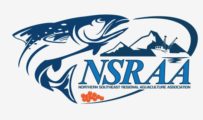Medvejie Hatchery is located near Sitka, Alaska and produces chum, Chinook and coho salmon. A temporary hatchery was built on the site in 1981 and construction of a permanent facility occurred in 1984. Funding for additional production allowed the expansion of Chinook capacity in 1987.
Medvejie’s chum program includes releases at Bear Cove, Deep Inlet, and Crawfish Inlet. Releases at Bear Cove and Deep Inlet include a portion of summer stock chum taken at Hidden Falls. Releases at Deep Inlet include a portion of fall stock chum reared in a cooperative arrangement with Sheldon Jackson Hatchery. All other fall stock chum for these projects are sourced from Medvejie Hatchery. Crawfish Inlet and a portion of Deep Inlet released fall chum are reared at Sawmill Creek Hatchery. Release goals include at least 50% of fry for all projects and stocks reared to 4.0 grams. Studies conducted in the early 2000’s in Sitka Sound suggest that fry this size at release will migrate offshore much faster and have exhibited higher survivals.
Most of the commercial harvest for Medvejie Projects in Sitka Sound occurs in Deep Inlet. Deep Inlet is a rotational fishery that allows access for all three gear groups to fish from June 1 through late September. By the later portions of the run, Deep Inlet is usually the only remaining fishery for the gillnet fleet and in years of lower pink salmon abundance, a hot spot for the seine fleet. Trollers also harvest these chum salmon, primarily just outside of the terminal harvest area. This fishery became exceptionally popular for the trollers in the early 2020’s, during which multiple record high values for NSRAA troll projects occurred.
Medvejie chum exhibited a similar fluctuation in age at return beginning in the 2010’s, but not as volatile as other NSRAA projects. Luckily, marine survival stayed more consistent throughout the period and occasional brood shortages could be managed by time and area closures to the intercepting fisheries.
Medvejie has a history of being Alaska’s most valuable hatchery chinook contributor, both sport and commercial, especially during recent years of restricted access to inside rearing Chinook stocks of concern in southeast Alaska. During the now heavily restricted spring fisheries, the largest aggregate of open area is in the offshore districts that intercept many Medvejie Chinook. As a result, Medvejie has now become the de facto spring troll target fishery and is of great importance to the fleet.
Medvejie undertook a major expansion of its yearling Chinook program in 1997. This expansion, which involves rearing fry in net pens in Green Lake, more than doubled the hatchery’s Chinook production at that time. Pens are constructed each year in the lake and fry are transported via truck for summer rearing. While the program has its challenges, it has enabled for a far greater Chinook rearing capacity than the hatchery would otherwise allow due to spatial constraints.
In addition to Green Lake rearing, Medvejie has been experimenting with zero check programs off and on for many years. This entails pushing the growth of these fish early to achieve saltwater competency in their first spring of rearing and releasing less than one year old. Staff have had difficulty attaining enough fish growth in the limited spring rearing window to reach release size goals of 20 grams per fish, so various improvements and trials have been made. These include improvements to the incubation and rearing processes, prioritizing the Zero-check component as the first lot of eggs fertilized in the spawning season, inline water heaters and recirculation systems to accelerate egg/alevin development during incubation phase, photoperiod manipulation to induce smolting during rearing, integrating blood chemistry analyses to optimize saltwater entry timing, and the use of spawning aids to induce gamete maturation.
The expansion of Sawmill Creek Hatchery is geared towards adding an additional 2 million chinook as we continue to fine tune the zero-check program and hope to integrate Keta River stock Chinook, who have a natural tendency to zero check.
Medvejie’s Coho program has undergone several brood stock changes and is now utilizing Salmon Lake stock, located just three miles from Medvejie at the head of Silver Bay. Medvejie releases all brood stock designated coho smolt in order to imprint at the hatchery, so they return as adults to perpetuate the program. Production targeted at common property fisheries is incubated at Sawmill Creek Hatchery and imprinted/released at Deep Inlet.
As a condition for this brood stock propagation, NSRAA operated the Salmon Lake weir project from 2007 – 2021, evaluating the adult returns to ensure that minimal hatchery/wild interactions were occurring in the lake, and wild escapements remained sustainable despite an increased harvest of hatchery produced coho released from Deep Inlet.








